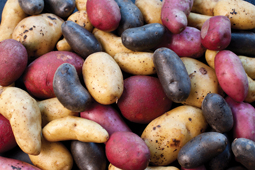As the top vegetable crop in the United States and the third-most consumed food crop worldwide (after rice and wheat), potatoes grown in the United States enjoy robust sales, split fairly evenly between the fresh market and processing.
Although potatoes are grown throughout the United States and Canada, in a variety of climates and soil types, several regions stand out as particularly well-suited to tubers. The United States once grew the majority of its potatoes in New York, Pennsylvania, and Maine (which still ranks among the top ten potato-producing states), but nineteenth-century westward expansion, along with innovations in irrigation and shipping put Idaho, Washington, and Oregon at the forefront of modern potato production.
The majority of potatoes in the United States (90 percent) are planted in the spring and harvested in the autumn, many stored for later sale. The small percentage of U.S. potatoes harvested during other seasons is mostly comprised of specialty varieties (such as round red, white, yellow, and purple potatoes). Potatoes flourish in sunny, mild weather; growers cite daytime highs in the upper seventies and low eighties and overnight lows in the forties and fifties as ideal.
Northwest: The Big Three
Temperatures, as well as the rich volcanic soil of the western United States, have fostered robust potato production in Idaho, Washington, and Oregon. Idaho and Washington alone produce over half of the nation’s spuds. The familiar and versatile Russet Burbank dominates in the Pacific Northwest, although the region also produces a plethora of other varieties.
In addition to an ideal range of temperatures during the growing season, Idaho potatoes receive much of their water from the surrounding mountains. The overwhelming majority of Idaho potato production remains in russets, although a number of reds, golds, and fingerlings are also grown in the Gem State. Well over half of Idaho potato sales are for processing, a third are for fresh consumption, and the rest are seed potatoes.
Although flat or declining U.S. potato consumption has posed a challenge for grower-shippers in recent years, Chris Wada, director of marketing for Idaho Falls-based Wada Farms Marketing Group, LLC, sees promise in new color varietals.
Innovation is ongoing: “We’re always looking to find and sustain the varieties that are good performers in appearance and eating characteristics,” he notes, referring to reds and golds, as well as the newer purple or dark blue potatoes with whiter flesh than existing varieties. Wada Farms has also responded to increasing demand for mini potatoes, which are easy to prepare and satisfy a sense of novelty for both children and adults.



